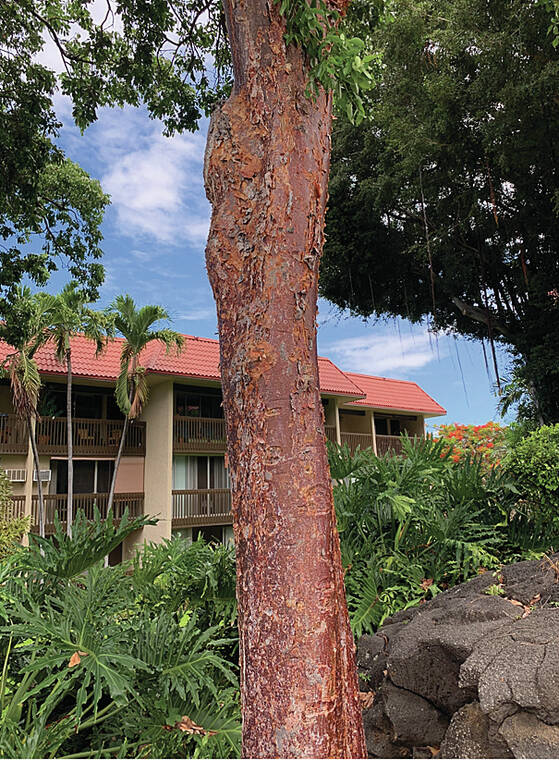Trees like the Jacaranda, Royal Poinciana and Plumeria are valued for their colorful and often fragrant flowers. Some on the other hand are notable due to their interesting bark.
A rare but easy to grow one is the Gumbo Limbo.The Bursera simaruba also called the Naked Indian Tree in the Caribbean is hard to miss because of its reddish shiny bark. It is also referred to as the Living Fencepost Tree since a cutting of almost any size will grow easily. It is often used as fence posts by farmers and ranchers in tropical America because it continues to grow and is resistant to termites and decay. Sometimes it is referred to as the Tourist Tree because its reddish trunk peels like a sun burned tourist.
The Gumbo Limbo is used as a landscape tree in South Florida because it is easy to propagate. Even cuttings ten feet tall can be quickly grown and profitable as a nursery item. It is also used as a shade tree for coffee farms and cacao in Central America. It has many medicinal uses and has been valued by indigenous peoples of the Caribbean, Central and South America for centuries. Nurseries here do not have the tree but if you are interested in getting cuttings, email me at bezona@hawaii.edu.
There are many other trees with interesting bark, especially in the Ohia family that includes Guava, Eucalyptus, Allspice and Mountain Apple.
One example is the Painted Eucalyptus, Eucalyptus deglupta, sometimes called Rainbow eucalyptus or Camouflage Tree, is a sight to behold and thanks to Kelly Dunn and his Painted Trees of Hawaii, these beautiful trees are being protected on our island. Of over 500 species of Eucalyptus, this is the only one found growing naturally north of the equator. It is native to the rainforests of the Philippines, Indonesia and New Guinea. It is related to Ohia so the flowers also attract our native Honeycreepers.
Speaking of our endemic honeycreepers, now is a great time to see several species feeding on the nectar of Ohia lehua in upland forests above 2000 feet like Kaloko Mauka in West Hawaii. Due to the easy access of only fifteen minutes from Kailua-Kona and the airport, it is an easy way to experience the forests of our island.
Upland forests of East Hawaii and Volcano National Park are also great for birding. Trees not only produce oxygen, they supply shade, act as windbreaks and lock up the carbon thatis the main cause of global warming. Scientists have shown that approximately twenty five percent of our carbon dioxide is sequestered by forests each year, so the more forests we plant the more we reduce the effects of global warming.
Many of Hawaii’s forests and forest watersheds are threatened. Not much can be done to stop foreign governments from forest destruction, but we can do a lot to protect and plant forests here.
Much of Kaloko Mauka is still covered with native forest and is unique cloud forest. The area abounds with ancient Ohia (Meterosideros polymorpha) and gigantic treeferns, some of which are 10 feet or more in height. These ferns may be over 100 years old since the trunks only grow 2 to 3 inches per year.
The native forest contains many rare and endangered species that local residents are committed to protect. These programs allow residents to dedicate and manage their properties to enhance this important and unique watershed. They are administered through the Hawaii Department of Land and Natural Resources Forestry Division, Hawaii Island Land Trust and Moku O Keawe Land Conservancy.
Kaloko Mauka is the home of the Hawaiian Hawk, Apapane, Iiwi, Elepaio, Amakihi and many other endemic and exotic birds. Kaloko Mauka has been identified as essential wildlife habitat and forest watershed. It is the goal of residents of Kaloko Mauka to set an example that they can live in harmony with the forest and still have homes and some forest friendly agricultural activities. This is essential if our island is to have the rainfall and watershed needed to supply communities at lower elevations with sufficient water.
The world’s Tropical forests include not only trees but under story palms, bromeliads, orchids, ferns and bamboos. Many palms worldwide are endangered due to the destruction of rainforests.
Fortunately, Hawaii is becoming a kind of Noah’s Ark thanks to the efforts of the Hawaii Island Palm Society, Bamboo Society, Orchid Societies, Rhododendron Society and other concerned groups. Not only is it vital to protect our remaining Hawaiian forests, but also reforest those abandoned cane lands of Hamakua, Puna, Kau and Kohala with biodiverse forests thus ensuring valuable resources for future generations. This is especially critical as we are losing our Ohia forests due to a fungus killing trees in many areas of the Big Island. For further information on forest planting and management, please contact UHCTAHR Extention Forester, J.B. Friday at (808) 959-8254 or jbfriday@hawaii.edu



